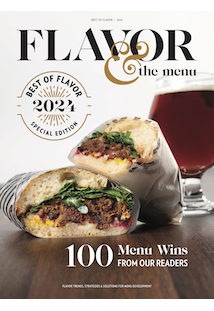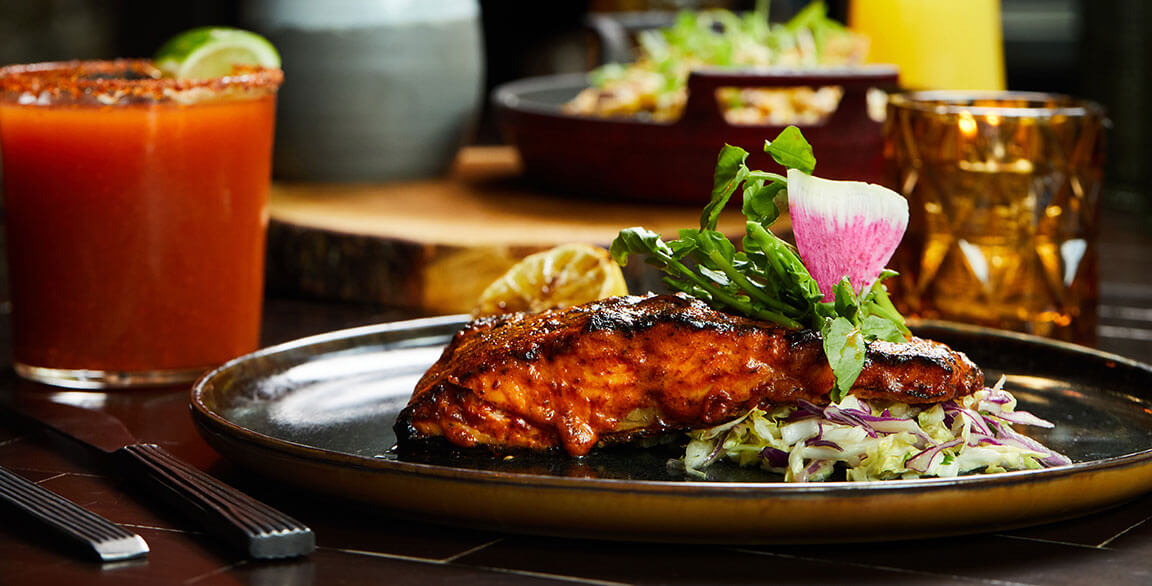

Trend watchers often get asked how they land on flavor forecasts. At Flavor & The Menu, our method is built on observation, immersion and information. We are steeped in the business of flavor every day, so much of the work feels as if it reaches us through osmosis, though it’s certainly more intentional than that. Of course, data informs trend analysis, but the meaty information comes from making sense of menu patterns, finding through lines in consumer preferences, connecting dots from micro trends to overarching shifts, and then contextualizing opportunities for menu developers.
Searching for threads in a potential new flavor direction or looking for an offshoot woven from those of an established trend is akin to collecting seashells on the beach. You’re not quite sure what you’re looking for, but you know it’s special when you see it.
The four concepts highlighted here each carry menu items that serve as trend markers. Taken on their own, the dishes and drinks are inventive, craveable and flavor forward, but observed through a wider lens, each illustrates much more: from an interesting new bend in the arc of global mash-ups to emerging breakfast stars to a revelation in beverage building.
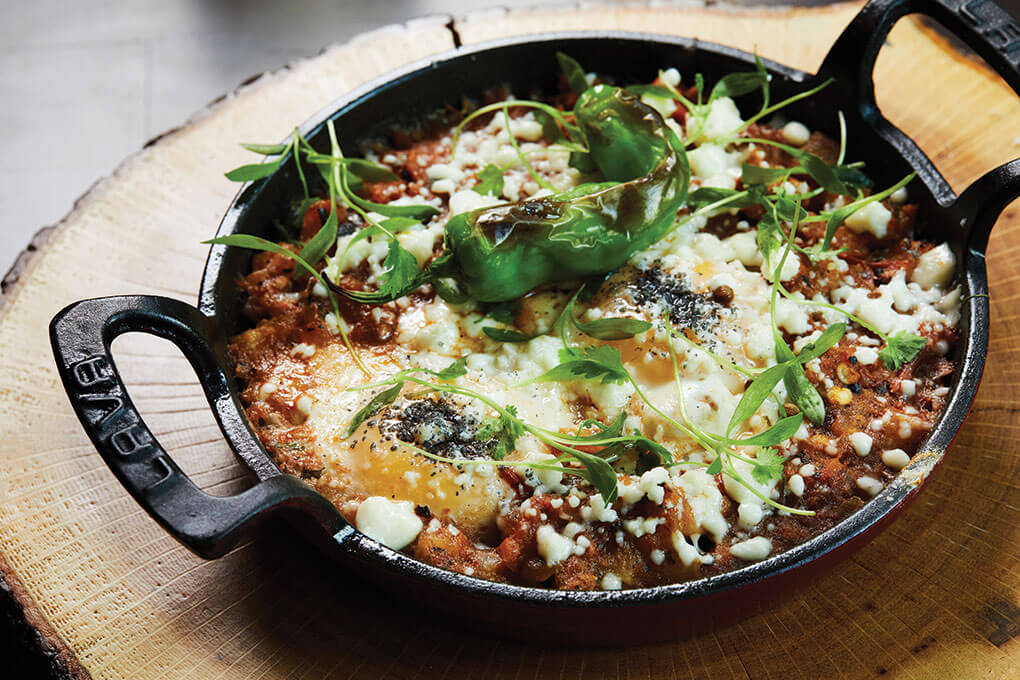 Photo credit: Front of House New York City
Photo credit: Front of House New York City Modern Mexican brunch at dLeña includes the Cazuela, featuring smoked eggs, charred tomato salsa, potato hash and panela cheese.
Exploring Mexico
Mexican cuisine has never faltered in its popularity with American diners, its hold stemming from a surefire trifecta of familiarity, comfort and craveability. Today, its draw has grown even deeper, stretching into regional flavor narratives and reaching back into long-established cultural traditions for menu inspiration.
Rather than translating flavors and dishes to suit American palates, there’s a new culinary voice that is instead celebrating the authenticity and diversity of Mexican cookery. That doesn’t necessarily mean replication of traditional dishes. There is still a modern sensibility at play on menus here that often brings in flavor touches from the global pantry.
Richard Sandoval’s modern Mexican restaurant dLeña in Washington, D.C., stands as an ambassador for this different approach in offering up a favorite and familiar cuisine to today’s diner. His brunch menu serves up a few prime examples.
“When we made the decision to create this menu, we wanted to include dishes from various regions in Mexico,” says Sandoval, chef and founder of Richard Sandoval Hospitality, with more than 45 contemporary Latin-themed restaurant concepts around the world, including Toro Toro and Maya. “It was important to us to do something different and showcase lesser-known dishes—ones that are equally delicious to the chilaquiles and the huevos rancheros that we all know and love.” Leveraging the brunch category’s broad parameters of what fits into that daypart, Sandoval menus dishes like Birria Beef Tacos, his take on the hugely popular stew, with radish, red onion, cilantro and green tomatillo relish.
For menu developers, his Cazuela offers an example of the next iteration of a craveable Mexican breakfast skillet, easily taking the baton from those chilaquiles and huevos rancheros. It stars smoked eggs, charred tomato salsa, potato hash and panela cheese. “The flavors of the cazuela are smoky and charred with a mild spice,” says Sandoval. “We crack a fresh egg on top of the hash then put the entire cazuela inside a wood-fired oven. The panela adds a creamy consistency that balances the smokiness of the dish.”
Not only is it exciting for many diners to experience “new” flavors from a cuisine that they have adopted as their own, further exploration into regionality and authenticity honors this rich food culture. It also tugs on nostalgia and comfort for a large number of immigrants and children of immigrants, both a significant swath of diners today.
Salmon Zarandeado is another dish on dLeña’s menu worth a closer look. Originating in Nayarit, Mexico, “zarandeado” is a 500-year-old method for preparing fish, where it is first marinated and then cooked slowly over a wood fire, absorbing the smoke and wood notes. At dLeña, Sandoval marinates the salmon in achiote, orange juice, beer, oregano and chipotle, grills the fish, and then serves it with an achiote mayonnaise.
“We are all about honoring the cooking of our mothers and abuelas,” says Sandoval. “It’s important that we keep expanding our view of Mexican cuisine and taste what every region of Mexico has to offer.”
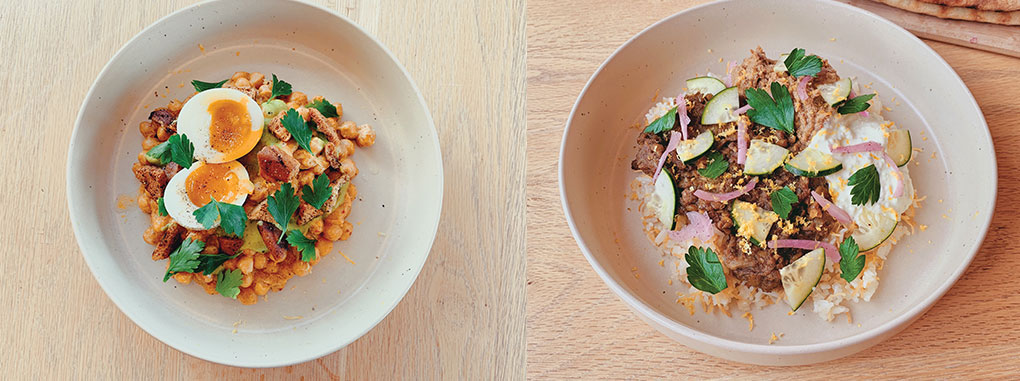 Photo credit: Hexenbelle / Heather Webber
Photo credit: Hexenbelle / Heather Webber Hexenbelle, a café in Traverse City, Mich., serves flavorful, comforting Middle Eastern mash-ups: Palestinian Rice Bowl with vermicelli rice, kofta lentils, makdous and shatta labneh (right); and Musabaha with warm chickpeas, tahini, chile-herb sauce and soft-boiled egg (left).
Middle Eastern Comfort
The role of mothers and grandmothers also plays into the depth of experience at Hexenbelle, a modern Middle Eastern restaurant in Traverse City, Mich. Its plant-forward menu is fascinating, given that it serves farm-driven Middle Eastern comfort food in the context of an all-day breakfast/lunch café in a small town in the Midwest.
Chef/owner Christian Geoghegan draws on his Palestinian roots and uses assertive flavors in surprising ways, opening up avenues in on-trend Middle Eastern mash-ups with new flavor introductions from ancient cultures.
He looks to musabaha, a whole-chickpea hummus, as a flavorful, plant-based offering and moves it into familiar breakfast territory with the addition of a six-minute egg, also incorporating a chile-herb sauce and toasted pita, seasoned with za’atar, Aleppo and salt, as a garnish.
“I wanted to make the dish dynamic, with tahini, Aleppo pepper, za’atar, garlic, lemon juice and the chile-herb sauce for acidity and color,” says Geoghegan.
Positioned as breakfast fare, Hexenbelle’s musabaha points to broader menu opportunities for chefs looking to tap into Eastern Med’s popularity. It also illustrates the potential for further flavor exploration in the breakfast daypart, a category that continually demonstrates an openness to new flavor horizons.
Geoghegan’s menu also pulls into focus a similar theme that Sandoval highlights at dLeña: the importance of expanding the view of a somewhat familiar global cuisine.
Sandoval references going deeper into the culinary heritage of Mexico’s varied regions. At Hexenbelle, Geoghegan is passionate about the inclusion of Palestinian dishes in the broader context of Middle Eastern cuisine. “Palestinian food is my home. It’s where I always come back to in my cooking, even though the food I like to make is also inspired by the Silk Road,” he says. “There’s an urgency in calling out Palestinian dishes, even though many dishes are similar to Lebanese, Syrian or, more broadly, Arabic. There’s a cultural erasure that’s going on with Palestinian cuisine. It’s important for that not to happen, and if we can celebrate the dishes, flavors and traditions of a country, we’re helping preserve that culture,” he says.
His Palestinian Rice Bowl succeeds in spotlighting the country’s cuisine while delivering a differentiated flavor experience that is decidedly craveable. It’s structured around texturally rich components with layered flavors behind each one. Geoghegan toasts vermicelli in housemade ghee and olive oil, adds basmati, coating and toasting them together. He adds water and salt, then cooks the mixture. Separately, he prepares kofta lentils, seasoning them aggressively with toasted cumin, smoked paprika, allspice, seven-spice mix, traditional kofta spice and Aleppo pepper. Another unique element of this bowl build is makdous, which is oil-cured, roasted eggplant seasoned with sumac, ras el hanout, za’atar, Aleppo and lemon juice, then blended with walnuts.
To plate, he lays down the rice and lentils, adds a quenelle of the makdous and a quenelle of housemade shatta labneh, then tops the bowl with sumac-pickled red onions, cucumber, parsley and lemon zest. “We go big in flavor,” says Geoghegan. “We want to deliver an emotional experience.”
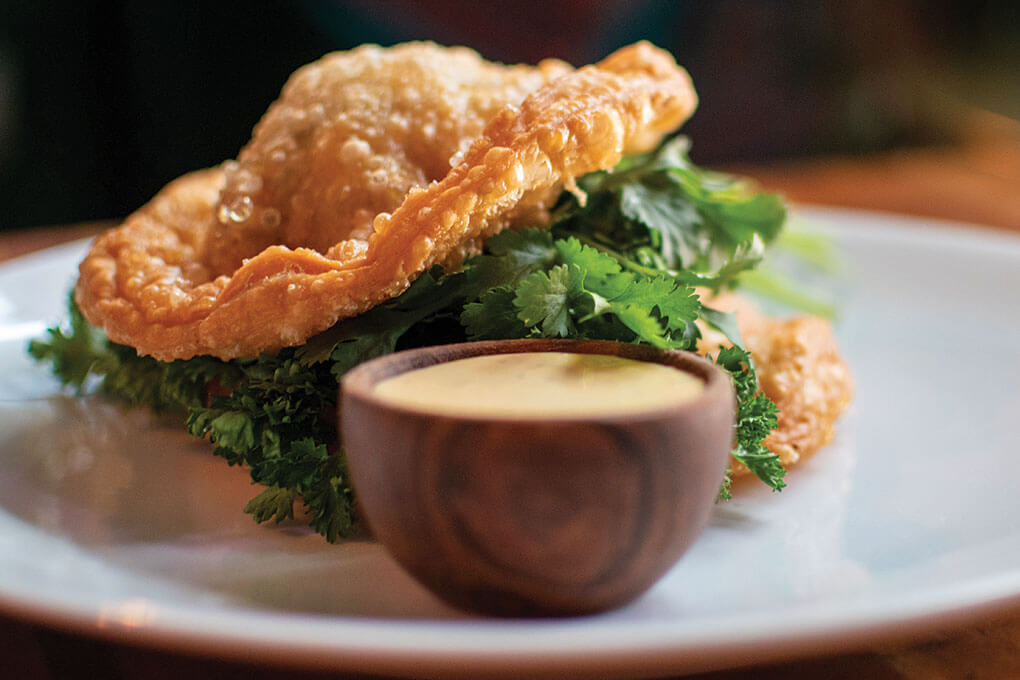 Photo credit: Dana Plucinski
Photo credit: Dana Plucinski Sobre Mesa’s Steak and Cheese Empanadas highlight Nigerian-Latino flavors with its steak suya, Oaxaca cheese, cheddar and salsa brava.
Cultural Perspective
We’re often enthralled by global mash-ups that spring to life through a clever fusion of wildly different yet complementary cultures and sensibilities. Roy Choi’s Korean-Mexican Kogi Taco is the clearest example, with dozens of other inspiring combinations influencing menus and helping to build upon the narrative of eclectic American cuisine.
Although certainly not new, mash-ups that are forged through historical circumstance—colonialism and immigration—are perhaps two of the biggest drivers here. This type of culturally diverse fusion cooking is making significant inroads on menus. And with that, it’s breathing new life into global flavor discoveries made manifest in dishes that are wholly original, reassuringly familiar and incredibly craveable.
Nelson German is a Dominican-American from Washington Heights, N.Y. In his role as executive chef/owner of Sobre Mesa, a cocktail lounge in Oakland, Calif., he serves up an intriguing fusion of Afro-Latino flavors, honoring his Dominican heritage while exploring his West African roots.
His Pork Tenderloin Pernil Style is served with a pineapple sofrito, sweet potato romesco and pickled pink apple shavings. “This dish is a tribute to my mom,” says German, a recent contestant on Bravo’s Top Chef. “In our culture, this dish is the main event, cooked during special events.” His take lightens and modernizes the traditional version, using a leaner cut of pork and modifying the marinade. “I use pineapple juice, Serrano and jalapeño peppers, cilantro, sofrito and shio koji, which both breaks down the meat and introduces umami,” says German. “The koji, derived from rice, brings in that tie to West Africa, which has a strong tradition of umami-rich ingredients, so it makes sense to pull these together into one dish that represents my heritage.”
After the pork is marinated for two days, he sears and roasts it, serving it with the romesco and pickled pink apple, a modern touch that brightens the dish with a hit of crisp acid.
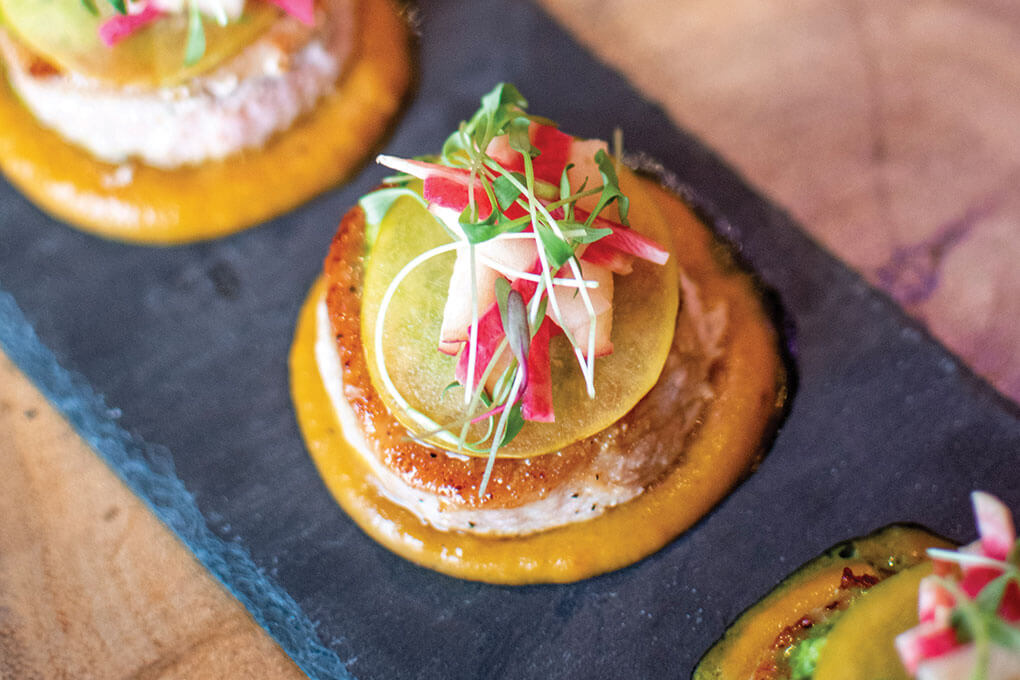 Photo credit: Dana Plucinski
Photo credit: Dana Plucinski At Oakland’s Sobre Mesa, the menu features Afro-Latino flavors. This Pork Tenderloin Pernil Style boasts pineapple sofrito, sweet potato romesco and pickled pink apple shavings.
German uses the Latin empanada to introduce his guests to “suya,” a seasoned, grilled beef street food from Nigeria. Served as a bar bite, his Empanada is filled with steak suya, along with Oaxaca cheese, two-year cheddar and salsa brava.
He also showcases a deft use of tropical flavors in American menu classics. His Chimichurri Jerk Wings feature chicken wings in duck fat confit, spiced with jerk seasoning and served with a chimichurri sauce. “It’s lush, vibrant and citrusy, with a nice little bit of sweet heat,” says German.
Like dLeña and Hexenbelle, Sobre Mesa is highlighting trend-forward, inventive fare on its brunch menu. In the context of Afro-Latino cuisine, German’s Salt Fish Chilaquiles offers a study in next-level fusion, taking a trending global dish and building layers of intrigue and story into its recipe. His version features a West African red fish stew made with salt cod, potatoes, onion, avocado purée, tortilla and egg. “It’s got the silky saltiness of the fish and the texture of the tortillas; then you break the yolk into it for richness,” he says.
There’s a sense of discovery on the menu, a personal narrative told through food that carries a joyful exploration of heritage, family, history and innovation.
“I’m really having fun with it,” says German, who also owns alaMar Kitchen & Bar, a seafood spot in Oakland. “I’m learning more about my African roots and then expressing that on the plate, really cooking my heritage and telling those flavor stories—Dominican, Taino, African, Spanish. Celebrating Black heritage and its influence in culinary traditions is so important.”
His menu showcases flavor combinations that lock up both craveability and broad appeal. These mash-ups represent the leading thread in an emerging trend pattern, yielding menu-ready ideas.
German’s Gambas al Ajillo combine the familiar with the new: Gulf shrimp are flavored with garlic confit and nit’ir qibe-spiced butter, introducing diners to the full-flavored Ethiopian clarified spiced butter that typically features gingery, citrusy, aromatic notes.
Pan-African flavors are becoming more prevalent on menus, thanks in part to chefs like German, who celebrate their personal ties through their menus. At Bussdown, a takeout and delivery-only spot operating out of a virtual kitchen in Oakland, the menu features Nigerian, Jamaican and West African-influenced dishes. Its tagline captures the essence of the broader opportunity: “Pan-African soul food concept encompassing traditional culture in nontraditional ways.”
 Photo credit: Vesta Coffee Roasters
Photo credit: Vesta Coffee Roasters Vesta Coffee Roasters’ menu carries specialty coffee drinks that are both refined and playful: the Candy Flip Latte (left) with Thai tea-coriander syrup, orange, espresso and gummy bears; and the Espresso Tonic with yuzu, coconut and passionfruit tonic.
Next-level Flavor Building
Flavor trends speed into the coffee and tea world on the fast track. Driven in large part by a thirst from younger consumers for fun, whimsical, adventurous choices, this beverage category is a hotbed of innovation. At Vesta Coffee Roasters in Las Vegas, the unique specialty coffee and tea menu lays out new pathways of creativity. Its progressive flavor combinations both surprise and delight, all while keeping the quality of ingredients in sharp focus.
Vesta, with two locations, serves specialty-grade coffee with traceable origins. The beans are roasted at least three times a week at its Arts District shop. It features today’s standards, including espresso, cortado, cold brew and nitro. But it’s the Specialty and Seasonal menus that draw the eye. Rotating offerings include a Salted Pistachio Latte, made with pistachio orgeat, espresso and pistachio dust, and the Candy Flip Latte with Thai tea-coriander syrup, orange and espresso, garnished with a playful skewer of gummy bears. It’s the most popular specialty drink on Vesta’s menu.
“I wanted something that was as excessive as possible,” says Jerad Howard, owner/operator. “One of our baristas was working on a Thai tea concentrate. We were trying to engineer a Fruit Loops flavor, so she combined orange oil, dry coriander and lemongrass and landed on this amazing flavor.” He’s careful with sugar ratios, keeping them low, even on a drink that has a gummy bear garnish. “Our coffee is really good, so we want it to shine,” says Howard. That refinement and finesse is noteworthy here. The menu showcases fun, lighthearted beverages without the heavy hand of sweetness that often drives the narrative in this arena.
Vesta’s Espresso Tonic is a blueprint on how to make a craveable signature. It features espresso paired with a custom-made tonic flavored with passionfruit, yuzu and coconut. “We engineer our own tonics, working with a craft tonic company,” says Howard. “With this particular drink, we want our guests to feel as if they were on the beach, far away—based on all that has been happening in the world. The flavors have to play well with coffee, and these do. The passionfruit has a good acidity that works well in an espresso tonic.”
Vesta’s Spa Day Matcha is another revelation, made with high-grade matcha, simple syrup, cucumber, mint, lime and sparkling water. The garnish is cocktail-like, adding to its appeal: a long, broad strip of fresh cucumber curls around the inside of the glass. “It’s our play on agua fresca, with a little Tiki feel to it. It’s even more popular than I thought it would be. It’s incredibly refreshing,” says Howard.
That play on alcoholic beverages in the cold coffee and tea space is a smart move, pulling in a treasure trove of proven flavor combinations and borrowing the swagger from cocktails. Vesta’s version of a Dark & Stormy, garnished with a nugget of candied ginger perched on a wheel of lime, stars espresso, ginger syrup, lime and soda water. “Our espresso is the play on dark rum featured in this cocktail. It’s coffee-centric, but brings in something new and different for our guests,” he says.
Howard’s approach to menu development is underpinned by his rule that it must be balanced and made with real ingredients. He then taps into the talent on his staff, opening up menu ideation contests with cash prizes and bragging rights. “Our specialty drinks move in and out and are often inspired by passionate, invested employees,” says Howard. “We have fun with the drinks and our guests love them, always keeping the quality of our ingredients as the star.”
These four concepts inspire, defined by passionate storytelling and original menu development.
 Photo credit: Vesta Coffee Roasters
Photo credit: Vesta Coffee Roasters
The Dark & Stormy at Vesta Coffee Roasters balances the dominant flavors in espresso with ginger syrup, lime and soda water.

